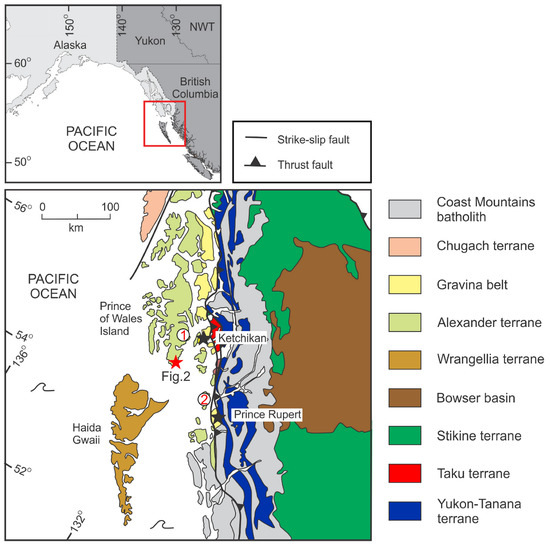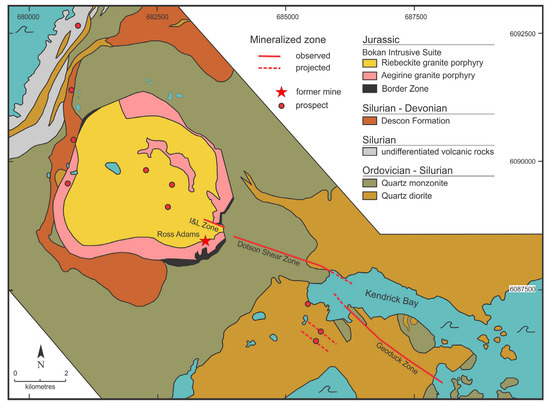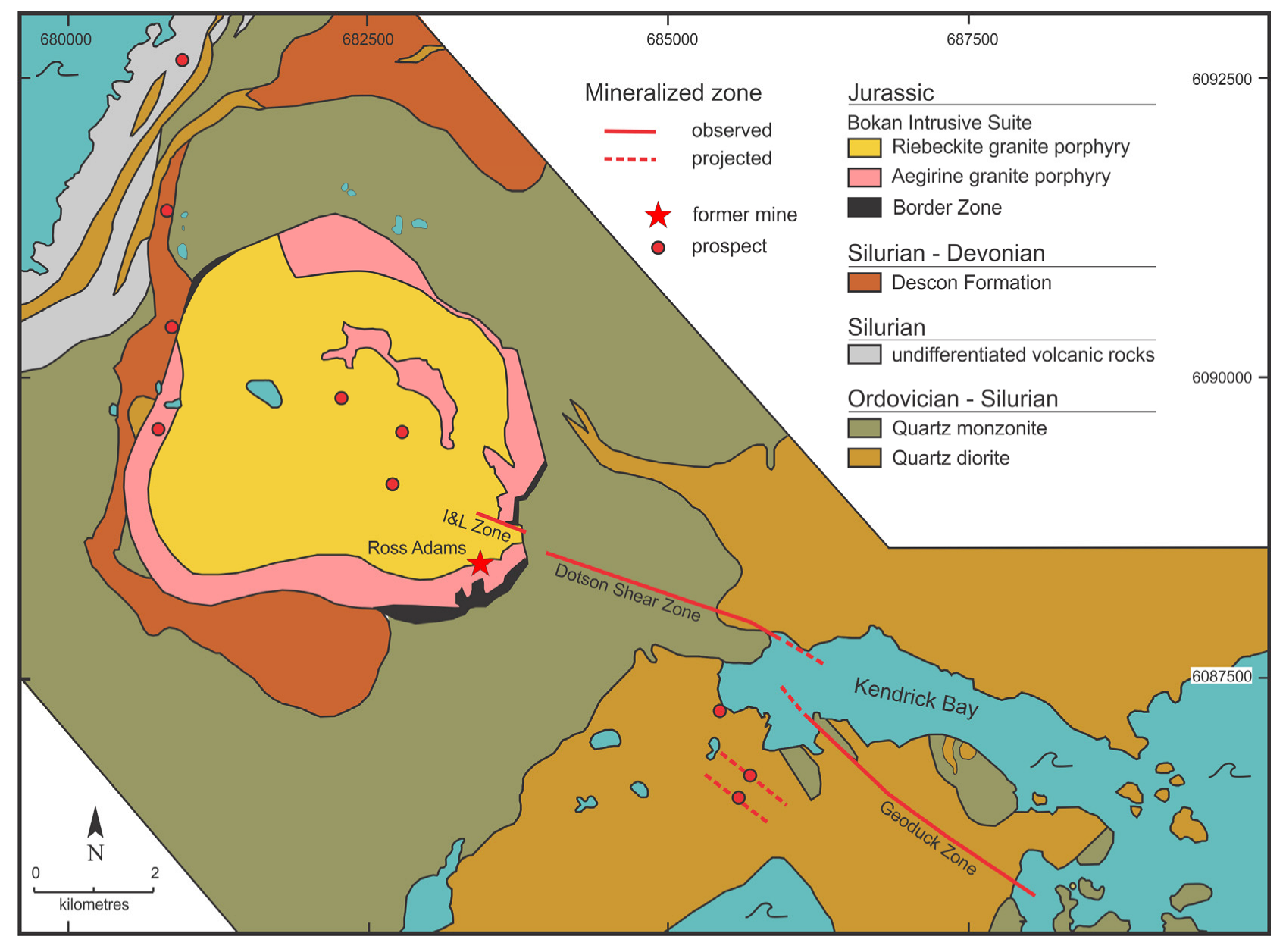You're using an outdated browser. Please upgrade to a modern browser for the best experience.
Please note this is a comparison between Version 2 by Rita Xu and Version 1 by Jaroslav Dostal.
The Lower Jurassic (ca. 177 Ma) Bokan Mountain granitic complex, located on southern Prince of Wales Island, southernmost Alaska hosts a high-grade uranium-thorium deposit with past production. The complex is a circular body (~3 km in diameter) which intruded Paleozoic granitoids as well as metasedimentary and metavolcanic rocks of the Alexander Terrane of the North American Cordillera.
- peralkaline granite
- Alaska
- uranium
- thorium
1. Introduction
Peralkaline granitic rocks are relatively rare rock-types, which are commonly enriched in rare elements (rare earth elements (REE), radioactive elements (uranium and thorium]) and high field strength elements (HFSE) such as Nb, Ta, and Zr). This enrichment can be of economic significance and has been a focus of recent exploration [1,2,3][1][2][3]. However, the origin of such mineralization is controversial. It has been ascribed to extensive fractional crystallization (e.g., [4,5,6][4][5][6]), late-stage magmatic-hydrothermal processes or low-temperature external hydrothermal fluids [7,8,9][7][8][9] or a combination of the processes [10,11,12,13][10][11][12][13]. To contribute to these discussions, this paper investigates the Bokan Mountain complex (BMC), a small peralkaline granitic intrusion in a southeastern part of Alaska, which hosts a high-grade uranium-thorium deposit with past production, as well as clusters of felsic dikes, which contain significant REE mineralization. The dikes occur along the margins or adjacent to the BMC in shear zones. The REE mineralization is distinct and ~1.5 km away from the uranium deposit, although both mineralization types are genetically related to the Bokan intrusion. Like other REE deposits associated with peralkaline felsic rocks, the Bokan REE mineralization is enriched in heavy REE as well as Y relative to total REE, while the Bokan uranium deposit is rich in Th.
Bokan Mountain (lat. 54°55′ N, long. 132°09′ W) is in southeastern Alaska, close to the southern end of Prince of Wales Island (the southernmost major island of Alaska). The complex is an approximately circular Jurassic intrusion (~177 Ma old) about 3 km in diameter, composed of highly fractionated peralkaline granitic rocks. The post-tectonic intrusion is well exposed and displays many geological characteristics typical of extension-related peralkaline granitic complexes worldwide (e.g., [14,15,16,17][14][15][16][17]).
2. Geologic Setting and Petrography
BMC lies within the Alexander Terrane of the North American Cordillera (Figure 1). The Cordillera consists of allochthonous oceanic and pericratonic terranes that were accreted to the northwestern margin of Laurentia (the North American craton) between late Paleozoic and early Cenozoic time (e.g., [21][18]). The Alexander terrane is a large outboard allochthonous terrane, which is considered to have an exotic nature with respect to the Laurentian margin (e.g., lack paleontological affinities with North America; [22,23][19][20]). The terrane (Figure 1) was accreted to the North American craton by the middle Cretaceous (~115–95 Ma), well after the emplacement of the Bokan complex.

Figure 1. Terrane map of southeastern Alaska and west coast of British Columbia. The map shows the location of Figure 2, the geological map of the Bokan Mountain Complex, southern Prince of Wales Island. The insert shows the location of Figure 1. Sites: 1—Dora Bay pluton; 2—Moffat volcanic rocks.


Figure 2. Geological sketch map of the Bokan Mountain complex and surrounding area showing the location of the former Ross-Adams mine and mineralization prospects including mineralized zones.
3. History of Mining and Exploration
After the 1955 uranium discovery in shear zones of the BMC by airborne and subsequently ground surveys [29][25], mining commenced in 1957 mainly due to incentive programs provided by the US Atomic Energy Commission [36,37][34][35]. The uranium mine was in operation intermittently between 1957 and 1971 and produced roughly 77,000 metric tons of ore averaging about 0.76 wt.% U3O8 and 3 wt.% ThO2 [35,37,38][33][35][36]. These concentrations are among the highest grades of U and Th ores ever mined in the United States and the Bokan is the only uranium deposit to have been mined in Alaska. The uranium ore was mined initially in a small open pit (50 × 110 × 7 m deep [36,37][34][35] located on the southeastern flank of Bokan Mountain at the Ross-Adams site (Figure 3). As the irregular cylindrical-shaped ore body plunges steeply at the end of pit, the deposit was subsequently developed as an underground operation through the establishment of two haulage adits (mine entrances). Ore was shipped by barge from the property to continental U.S. for processing, to fulfill contracts with the U.S. Atomic Energy Commission [1]. The mine stopped operations in 1971, due to depressed prices for uranium, leaving some uranium ore in the ground [38][36]. Subsequently, several companies carried out exploration in the BMC area during 1971–1981 [33,37,38][31][35][36].
Figure 3. (A) Abandoned Ross-Adams open-pit mine; (B) A southern part of the Ross-Adams pit mine with an adit. Host granites show distinct fracture-cleavages parallel to faults, which controlled emplacement of the deposit.
References
- Long, K.R.; Van Gosen, B.S.; Foley, N.K.; Cordier, D. The Principal Rare Earth Element Deposits of the United States—A Summary of Domestic Deposits and a Global Perspective; Scientific Investigations Report 2010-5220; U.S. Geological Survey: Reston, VA, USA, 2010; 96p.
- Verplanck, P.L.; Van Gosen, B.S.; Seal, R.R.; McCafferty, A.E. A Deposit Model for Carbonatite and Alkaline Intrusion-Related Rare Earth Element Deposits; Scientific Investigations Report 2010-5070-J; U.S. Geological Survey: Reston, VA, USA, 2014; 58p.
- Dostal, J. Rare metal deposits associated with alkaline/peralkaline igneous rocks. Rev. Econ. Geol. 2016, 18, 33–54.
- Cuney, M. Felsic magmatism and uranium deposits. Bull. Soc. Geol. Fr. 2014, 185, 75–92.
- Cuney, M.; Kyser, K. Magmatic processes involved in uranium deposit formation. In Geology and Geochemistry of Uranium and Thorium Deposits; Cuney, M., Kyser, K., Eds.; Mineralogical Association of Canada, Short Course Series: Quebec City, QC, Canada, 2015; Volume 46, pp. 99–138.
- Boily, M.; William-Jones, A.E. The role of magmatic and hydrothermal processes in the chemical evolution of the Strange Lake plutonic complex, Quebec/Labrador. Contrib. Mineral. Petrol. 1994, 118, 33–47.
- Salvi, S.; Williams-Jones, A.E. The role of hydrothermal processes in the granite-hosted Zr, Y, REE deposit at Strange Lake, Quebec/Labrador: Evidence from fluid inclusions. Geochim. Cosmochim. Acta 1990, 54, 2403–2418.
- Salvi, S.; Williams-Jones, A.E. The role of hydrothermal processes in concentrating HFSE in the Strange Lake peralkaline complex, northeastern Canada. Geochim. Cosmochim. Acta 1996, 60, 1917–1932.
- Linnen, R.L.; Cuney, M. Granite-related rare-element deposits and experimental constraints on Ta–Nb–W–Sn–Zr–Hf mineralization. In Rare-element Geochemistry and Mineral Deposits; Linnen, R.L., Samson, I.M., Eds.; Geological Association of Canada: St. John’s, NL, Canada, 2005; Volume 17, pp. 45–68.
- Salvi, S.; Williams-Jones, A.E. Alkaline granite-syenite deposits. In Rare-element Geochemistry and Mineral Deposits; Linnen, R.L., Samson, I.M., Eds.; Geological Association of Canada: St. John’s, NL, Canada, 2005; Volume 17, pp. 315–341.
- Gray, T.R.; Hanley, J.J.; Dostal, J.; Guillong, M. Magmatic enrichment of uranium, thorium and rare earth elements in late Paleozoic rhyolites of southern New Brunswick, Canada: Evidence from silicate melt inclusions. Econ. Geol. 2010, 106, 127–143.
- Dostal, J. Rare Earth Element Deposits of Alkaline Igneous Rocks. Resources 2017, 6, 34.
- Dostal, J.; Gerel, O. Rare Earth Element Deposits in Mongolia. Minerals 2023, 13, 129.
- Bowden, P. The geochemistry and mineralization of alkaline ring complexes in Africa (A review). J. Afr. Earth Sci. 1985, 3, 17–39.
- Bowden, P.; Black, R.; Martin, R.F.; Ike, E.C.; Kinnaird, J.A.; Batchelor, R.A. Niger-Nigerian alkaline ring complexes: A classic example of African Phanerozoic anorogenic mid-plate magmatism. Geol. Soc. Spec. Publ. 1987, 30, 357–379.
- Richardson, D.G.; Birkett, T.C. Peralkaline rock associated rare metals. In The Geology of North America; Eckstrand, O.R., Sinclair, W.D., Thorpe, R.I., Eds.; Geological Society of America: Boulder, CO, USA, 1996; Volume P-1, pp. 523–540.
- Bonin, B. A-type granites and related rocks: Evolution of a concept, problems and prospects. Lithos 2007, 97, 1–29.
- Colpron, M.; Nelson, J.L.; Murphy, D.C. Northern Cordilleran terranes and their interactions through time. GSA Today 2007, 17, 4–10.
- Colpron, M.; Nelson, J.L. A Palaeozoic Northwest Passage: Incursion of Caledonian, Baltican and Siberian terranes into eastern Panthalassa, and the early evolution of the North American Cordillera. In Earth Accretionary Systems in Space and Time; Cawood, P.A., Kröner, A., Eds.; Geological Society of London: London, UK, 2009; Volume 318, pp. 273–307.
- Colpron, M.; Nelson, J.L. (Eds.) Paleozoic Evolution and Metallogeny of Pericratonic Terranes at the Ancient Pacific Margin of North America, Canadian and Alaskan Cordillera; Geological Association of Canada: St. John’s, NL, Canada, 2006; Volume 45, 523p.
- Gehrels, G.E.; Saleeby, J.B. Geology of southern Prince of Wales Island, southeastern Alaska. Geol. Soc. Am. Bull. 1987, 98, 123–137.
- Dostal, J.; Karl, S.M.; Keppie, J.D.; Kontak, D.J.; Shellnutt, J.G. Bokan Mountain peralkaline granitic complex, Alexander terrane (southeastern Alaska): Evidence for Early Jurassic rifting prior to accretion with North America. Can. J. Earth Sci. 2013, 50, 678–691.
- Karl, S.M.; Barker, J.C.; Dostal, J. Structural controls on emplacement of Early Jurassic peralkaline granite and rare earth mineralization at Bokan Mountain, southeast Alaska. Geol. Soc. Am. Abstr. Programs 2014, 46, 782.
- Barker, J.C.; Van Gosen, B.S. Alaska’s rare earth deposit and resource potential. Min. Eng. 2012, 64, 20–32.
- MacKevett, E.M., Jr. Geology and Ore Deposits of the Bokan Mountain Uranium-Thorium Area, Southeastern Alaska; U.S. Goverment Publishing Office: Washington, DC, USA, 1963; Volume 1154, 125p.
- Gehrels, G.E. Geologic Map of the Southern Prince of Wales Island, Southeastern Alaska; Map 1-2169, Scale 1:63,000; U.S. Geological Survey: Reston, VA, USA, 1992.
- Thompson, T.B.; Pierson, J.R.; Lyttle, T. Petrology and petrogenesis of the Bokan granite complex, southeastern Alaska. Geol. Soc. Am. Bull. 1982, 93, 898–908.
- Dostal, J.; Kontak, D.J.; Hanley, J.; Owen, V. Geological Investigation of Rare Earth Element and Uranium Deposits of the Bokan Mountain Complex, Prince of Wales Island, southeastern Alaska; U.S. Geological Survey Mineral Resources External Research Program—Report GO9PA00039; U.S. Geological Survey: Reston, VA, USA, 2011; 122p.
- Dostal, J.; Kontak, D.J.; Karl, S.M. The Early Jurassic Bokan Mountain peralkaline granitic complex (southeastern Alaska): Geochemistry, petrogenesis and rare-metal mineralization. Lithos 2014, 202–203, 395–412.
- Philpotts, J.A.; Taylor, C.D.; Tatsumoto, M.; Belkin, H.E. Petrogenesis of Late-Stage Granites and Y-REE-Zr-Nb-Enriched vein Dikes of the Bokan Mountain Stock, Prince of Wales Island, Southeastern Alaska; Open File Report 98-459; U.S. Geological Survey: Reston, VA, USA, 1998; 71p.
- Thompson, T.B. Geology and uranium-thorium mineral deposits of the Bokan Mountain granite complex, southeastern Alaska. Ore Geol. Rev. 1988, 3, 193–210.
- Thompson, T.B. Uranium, Thorium, and Rare Metal Deposits of Alaska. Econ. Geol. Monogr. 1997, 9, 460–482.
- Staatz, M.H. I&L uranium and thorium vein system, Bokan Mountain, southern Alaska. Econ. Geol. 1978, 73, 512–523.
- Stephens, F.H. The Kendrick Bay project. West. Min. 1971, 44, 151–158.
- Keyser, H.J.; McKenney, J. Geological Report on the Bokan Mountain Property, Prince of Wales Island, Alaska; NI 43-101 Report; Landmark Minerals Inc.: Toronto, ON, Canada, 2007; 48p.
- Warner, J.D.; Barker, J.C. Columbium and Rare Earth-Bearing Deposits at Bokan Mountain, Southeast Alaska; Open-File Report 33-89; United States Bureau of Mines: Washington, DC, USA, 1989; 196p.
- Bentzen, E.H.; Ghaffari, H.; Galbraith, L.; Hammen, R.F.; Robinson, R.J.; Hafez, S.A.; Annavarapu, S. Bokan Mountain Rare Earth Element Project near Ketchikan, Alaska; Preliminary Economic Assessment—NI 43-101; Tetra Tech.: Vancouver, BC, Canada, 2013; 227p.
More
